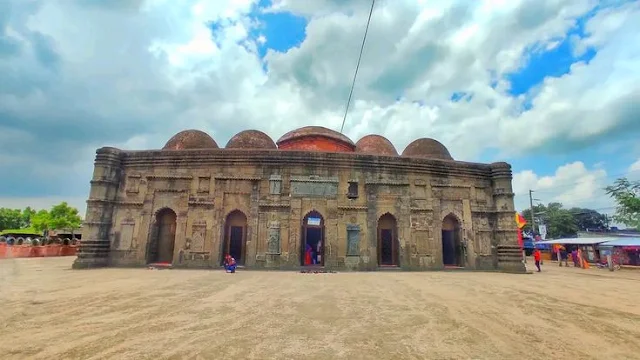Chapai Nawabganj District: A Hidden Gem in Bangladesh
Table of Contents
| Key Topic | Description |
|---|---|
| Introduction | Overview of Chapai Nawabganj and its significance in Bangladesh. |
| Geographical Location | Where Chapai Nawabganj is located and its regional context. |
| History of Chapai Nawabganj | Historical background and important landmarks of the district. |
| Culture and Traditions | Insights into the rich cultural heritage of Chapai Nawabganj. |
| Economy and Agriculture | The economic importance of agriculture, especially mango farming. |
| Tourist Attractions | Key places to visit in Chapai Nawabganj. |
| Local Cuisine | A look at the popular food and culinary experiences in the region. |
| Transportation and Accessibility | How to get to Chapai Nawabganj and its infrastructure. |
| Conclusion | Summary of why Chapai Nawabganj should be on your travel list. |
Geographical Location
Chapai Nawabganj is situated in the Rajshahi Division of Bangladesh, bordering India to the west. This district lies along the banks of the Ganges River (Padma), offering stunning views and fertile land. Its strategic location, near the international border with India, has made it a melting pot of cultural influences from both countries. The district covers a mix of urban and rural landscapes, with vast fields, small towns, and traditional villages.
History of Chapai Nawabganj
Chapai Nawabganj has a rich history that traces back to the Mughal era. The name "Nawabganj" is derived from the Nawab rulers who governed the region during the Mughal period. The district is known for its historical significance, with several forts, mosques, and buildings that reflect the past grandeur. Chapai Nawabganj also served as a key trade route during the colonial period, connecting different regions of Bengal and India.
One of the notable historical sites is the Gajner Fort, a Mughal-era structure that still stands today as a testament to the district's past. The fort is surrounded by lush greenery and offers visitors a glimpse into the architectural styles of that era.
Culture and Traditions
The cultural fabric of Chapai Nawabganj is deeply influenced by its agricultural roots and historical past. The people of the district take great pride in their traditional customs, festivals, and local crafts. The district celebrates major Bangladeshi festivals such as Eid-ul-Fitr, Eid-ul-Adha, and Pohela Boishakh (Bengali New Year) with grand celebrations.
The folk music of Chapai Nawabganj, particularly Baul songs, is a significant part of the local culture. These songs, often related to spiritual themes and rural life, are performed in various local events and gatherings.
Economy and Agriculture
Chapai Nawabganj is primarily an agricultural district, known for its fertile soil and favorable climate, which supports a wide range of crops. The district’s economy is largely driven by farming, with a focus on rice, jute, and mango cultivation. Mangoes, especially the famous Langra and Himsagar varieties, are a major export of Chapai Nawabganj, making it one of the most important mango-producing regions in Bangladesh.
Besides mangoes, the district is also known for its production of pulses, vegetables, and fruits. The agricultural community here plays a pivotal role in sustaining the local economy, and the government has been supporting various initiatives to boost crop yields and introduce sustainable farming practices.
Tourist Attractions
While Chapai Nawabganj may not be a widely recognized tourist hotspot, it offers several places of interest that make it worth visiting. Here are some notable attractions:
- Gajner Fort – A historical site built during the Mughal era, offering a view of the past architecture.
- Shibganj – A well-known area in Chapai Nawabganj famous for its mango gardens.
- Padma River – Visitors can enjoy scenic views of the river, especially during the monsoon season, when the river is in full flow.
- Mango Orchards – During the mango season (from May to July), the orchards are a sight to behold, with trees laden with ripe fruit. It’s a must-visit if you're in the district at the right time.
Local Cuisine
The food culture in Chapai Nawabganj is deeply rooted in Bengali traditions, with rice and fish forming the staple diet. You can find an array of mouthwatering local dishes such as:
- Shorshe Ilish (Hilsa fish in mustard sauce)
- Panta Bhat (fermented rice)
- Mango Chutney – A must-try during mango season, prepared using locally grown mangoes.
- Chingri Malai Curry (prawn cooked in coconut milk)
The district’s fresh ingredients, especially its mangoes, play a central role in the cuisine, making it an exciting place for food lovers.
Transportation and Accessibility
Chapai Nawabganj is easily accessible from the capital, Dhaka, via road. The distance from Dhaka to Chapai Nawabganj is approximately 300 kilometers, and it takes around 6 to 7 hours to reach by car or bus. The district is well-connected by the national highway network, and local transportation options include buses, auto-rickshaws, and cycle vans.
For those traveling internationally, the nearest airport is Shah Makhdum Airport in Rajshahi, which is around 45 kilometers away from Chapai Nawabganj. From Rajshahi, travelers can reach Chapai Nawabganj by road.
Conclusion
Chapai Nawabganj is a district full of charm and untapped potential, offering a rich cultural experience, historical landmarks, and natural beauty. Whether you are a history enthusiast, a nature lover, or a foodie, this district has something to offer. Its tranquil environment, combined with the warmth of the local people and the fragrance of mango orchards, makes it a perfect off-the-beaten-path destination. If you’re looking to explore rural Bangladesh and its authentic lifestyle, Chapai Nawabganj should definitely be on your travel list.



No comments:
Post a Comment